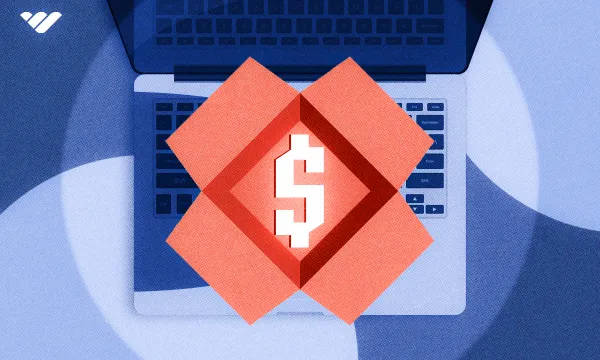In today’s market, digital products are outperforming their physical counterparts, and it’s easy to see why. Digital products require little time and money investment. Plus, they can help you earn a passive income - and who doesn’t like to see their bank balance increase even while sleeping?
With a whole range of businesses and individuals going down the digital route, it might just be time to jump on the bandwagon and begin to earn passive income. This will add another revenue stream with minimal effort, and you can use the additional time to have fun, relax, or focus on other projects.
Don’t know where to start or how to sell online? Fear not, as we’ve created this guide just for you!
In this comprehensive guide, you’ll learn everything there is to know about what digital products are, which are the best ones to create, and how you can start selling them using an online marketplace like Whop.

Whop is the leading online marketplace for next-generation entrepreneurs who want a reliable platform to kickstart their digital dreams. Once you’re ready to launch your digital product, head over to Whop.com and join over 7,000 active sellers who earn passive income by selling digital products on the platform.
About Digital Products 🖥️
Let’s start with a few basics: what exactly is a digital product? For centuries, the term “product” has been used to describe tangible objects exchanged between individuals for money or other goods. However, as our society evolved, products lost their tangible prerequisite and are now classified as physical, digital (or virtual), and even services.
So, a better and more modern definition of a product is something that can be marketed and sold and provides innate value to a customer. If it’s also a non-tangible object that’s primarily sold online, it’s called a digital product. The “value” a digital product provides to its audience comes down to fulfilling a specific need for them, solving one of their problems, or simply satisfying a desire.
Digital products are very common nowadays and are even more profitable than physical goods, with much lower logistics costs and lower initial investment. Plus, they're a great way to earn passive income since most come with very low maintenance requirements.
Depending on how much effort you put in and how passive you want your digital product to be will determine the amount of money it will make you. For instance, completely passive income digital products need minimal effort but also gather less traffic and income. Conversely, a product you update frequently provides added value to your customer, which warrants a higher price tag and more sales.
Pros of Selling Digital Products
Digital products come with plenty of benefits, which makes them highly sought-after by businesses. Some of the most significant advantages of digital goods are the following.
Easier to Create
One of the best things about digital products is they’re usually very easy to create. Simple products, like certain templates or small tutorials, can literally take just a few hours to complete, and they’ll earn you tons of passive income. Plus, most people create digital products out of skills they already have expertise in, so it can take even less time to make your end product.
What’s more, digital products require very minimal initial investment to produce. For most of them, you won’t need to spend any money whatsoever - all you’ll need to invest is time. If you need to learn a new skill to create your product, it may require some small investment and more time, but it’ll definitely be worth it in the long run.
No Shipping Costs
The virtual nature of digital products gives them a significant edge over physical products - you don’t need to pack and ship them to your customer! Instead, once each customer completes their transaction, they'll immediately receive the digital product in their email.
The lack of shipping costs means there’s an even larger profit margin for digital products, as logistics and shipping are among the biggest expenses for any physical goods business. Plus, you don’t need to spend time processing and shipping orders, making digital goods even more passive.
No Inventory Space Needed
In the same vein, you don’t really need to worry about purchasing and maintaining an inventory of items like a traditional commerce business would. All your “inventory” is digital and is created instantly when a customer orders your product.
This saves a lot of time, money, and hassle, as there’s no need to finance a warehouse to maintain an inventory, nor do you need to constantly order new stock. Instead, you can just passively earn money by selling your digital products online and let the marketplace you use handle all of the “logistics”.
Global Market
What’s better than having basically no logistics cost? The ability to sell your product worldwide without having to worry about things like customs and duties, shipping restrictions, or limitations in available inventory.
Digital products allow you to reach an even larger audience, as literally anyone can just purchase them from wherever they are. This enables you to create specialized products for very specific purposes since they’ll reach your target audience anywhere in the world if you market them properly.
Easy To Scale
Finally, with digital products, your ability to scale is basically limitless. Compared to traditional stores with physical products, you don’t need to deal with new brick-and-mortar locations for stores or warehouses, differences in shipping and logistics, or hiring more staff to help run the business.
Instead, you can just decide to create additional digital products for different purposes and sell them within the same platform you’re using already. That’s because most of these marketplaces allow you to list multiple products at no additional cost, which makes scaling your business a breeze.
Cons of Selling Digital Products
Even though digital products have lots of strengths that make them great for earning passive income, they also come with a few important downsides you should be aware of.
Intangible Goods
One of the biggest strengths of digital products is also one of their largest weaknesses. Not having a physical product might seem great for you in terms of logistics. But it can be deterring for many customers out there who want to feel like they’re purchasing something tangible. Since you can’t really create tangible digital goods, you have two options to deal with this issue.
The first is to ignore this part of the market and focus on the customers who don’t care if your product is digital or those specifically looking for digital products. The second is to convince people that your product is what they need, regardless of whether it’s tangible or not, through your marketing and additional services, such as troubleshooting and updates.
Not Easy to Showcase Value
This goes hand-in-hand with the tangibility issue mentioned above, as the lack of an actual physical product might make it hard to demonstrate its value. While most customers are slowly getting acquainted with digital products providing actual value, you may come across certain groups of people who’ll be harder to convince to buy your product.
What’s even more frustrating for some digital product businesses is overcoming the lower perceived value of their goods. The market sometimes views digital products as “lower value” since they aren’t physical and, therefore, don’t warrant a large price.
But you shouldn’t fall into the trap of selling your product at a lower price just to attract more customers. You want dedicated clients who will gladly pay for your premium product as they see its true value and will return to purchase other products from you further down the line.
Highly Competitive Market
There’s no beating around the bush: everyone is catching up on the digital product trend and is creating amazing products. This makes for a very competitive market, especially in certain fields. So, what can you do to differentiate your products from everyone else?
Your best bet is to create a very specific product for a very specific problem that’s ideally a hassle to solve. This way, the customers who want a solution to this unusual but cumbersome problem will be willing to pay more for a good product that will help them. Simply put, find your specialty and hone it to perfection.
Alternatively, you can out-market other products by using clever means to convey your message to your target audience. In a sea of good products, the ones with better marketing are usually what people go for.
7 Best Digital Product Ideas to Earn Passive Income 💡
If you’re struggling to decide which digital product you want to create or simply want some inspiration, have a look below at some of the most popular digital products right now.
Online Courses
Online courses are arguably the best and most profitable way to earn passive income by selling digital products. In today’s world, people are constantly looking to learn new skills to help with their jobs, while others are looking to change careers. And, of course, there are those who are just looking to discover new hobbies and activities in their free time.
With easy access to them through the internet, as well as the ability for customers to do things at their own pace and not having to deal with other people (for better or worse), online courses are thriving in the current market.
Before you start building your online course, you need to identify a skill you’re good at. This can be anything from cooking or knitting to running a successful business. Find your niche and learn how you can convey your knowledge and expertise to others.
Then, it’s just a matter of researching the market, finding your branding, and creating the course itself. Don’t forget about marketing too, as you’ll need to advertise your course to attract more customers.
Ebooks
Ebooks were one of the earliest digital products being sold, even before the latter became mainstream. Whether it’s fiction novels, gardening books, or just self-improvement books, there are plenty of ebook genres to tackle and find something you enjoy writing about.
Nowadays, ebooks are a way to bundle specific knowledge or skills you have in a neat package and offer it to the world. Compared to online courses, which usually require a lot more time and focus to properly complete, ebooks can be a great companion throughout your daily activities, such as commuting.
Most people avoid creating and selling ebooks because they think they don’t know how to write properly. However, that’s not really the case, nor do you need to be Stephen King to write a simple ebook using the knowledge you already have.
Just make sure to provide valuable information throughout the book and develop a good hook for your readers in the beginning. Also, treat it like a presentation; use images and graphs to illustrate your points and maintain the reader’s attention.
Digital Art
The increase in popularity of digital products has helped artists and creators promote their work immensely. Digital art products are highly sought-after by many people and can be very profitable. Plus, you have dozens of options on what kind of art you want to create.
If you’re good at drawing, you can create digital art prints and sell them online to people who like your art style. Once you build a loyal customer base, you can even work on a commission model and basically draw what customers ask for.
Another aspect of digital art is creating logos or graphic designs for businesses. With so many businesses going digital, they need to have engaging and attractive logos and graphics to use for different purposes.
You can also utilize your creative mind to make themes for different purposes. There are several businesses looking for attractive WordPress themes for their website, and you can even create themes for peoples’ computers or mobile devices.
Templates & Presets
With so many people using specific software and apps in their daily activities, there has been an increase in demand for certain templates and presets. These can be very valuable to people who want to organize their workflow better or learn how to use certain apps efficiently.
Popular apps that have a huge market for templates or presets include Notion and Lightroom. Notion is a productivity app that helps organize the work and life of people, as well as businesses, and there’s a huge market for Notion templates that help you manage things better. As for Lightroom, if you’re a fan of photography and have plenty of presets already, you can just sell them online to make some extra money.
Finally, lots of businesses, as well as people, are looking for PDF templates that have a nice layout with text and images to create professional-looking documents. You can create PDF templates for resumes, business letters, or even invoices and sell them for some passive income.
Discord Servers & Telegram Channels
Telegram and Discord have taken over as two of the best tools for communicating among members of a large community, as well as sharing files and announcements. What started as a simple messaging app and software to chat and share media with your friends has become the go-to place for managing a community of members with the same interests and goals.
Whop is the best marketplace for selling memberships to different services, including access to very active Discord servers. There are tons of excellent communities about trading, reselling, and even sports picks.
If you want to sell your own Discord servers, the first thing you’ll need to do is find something you’re good at and create the server itself. Then, once you’re ready to launch, sign up with Whop and add your server to the Whop marketplace. Whop also offers the Whop Bot, which will help you manage your server better, especially if you don’t have a lot of time available.
Stock Photos
If your hobby is photography, you can utilize it to create stock photos, which you can then sell online to earn passive income. It’s very common nowadays for all types of content to come with pictures to illustrate their points better or just present things in a more aesthetically pleasing manner.
Since content creators and businesses can’t just use random photos from the internet for fear of copyright infringements, they usually turn to websites with large stock photo libraries. Here, they buy out stock photos or license their usage for a certain time period.
All you need to do is provide original photos, for which you’re the copyright owner, and you can just earn passive income every time someone purchases your photo. It might not amount to a large amount of money, but it’s one of the most maintenance-free digital products you can sell.
Software & Plugins
If you’re good with coding, you can create standalone software apps that your customer can download and use on their computer or web browser.
The possibilities are endless when it comes to software, and you can essentially create anything you want, from project management tools to help with productivity to fully-fledged apps for Windows, MacOS, or Linux, or even mobile apps and games.
Another great option is plugins, such as WordPress plugins or ChatGPT plugins. The latter is particularly popular currently, with many people looking to take full advantage of ChatGPT and AI in general.
How to Start Selling Your Digital Products Today 💰
Interested in starting your own digital product business? Here’s what you’ll need to do to get started:
Research the Market & Find your Target Audience
The first, and arguably most important, step you’ll need to do before you start creating anything is to research the market thoroughly. The ubiquitous nature of digital products in our modern world has made their market highly competitive and saturated. There are tons of great products out there, and you'll need to create something truly exceptional to stand out.
You’ll probably not be able to build something excellent on your first try, though, so your best option is to create something unique. Determine your target audience, which are your main customers for the product, and find an issue not many people have but those dealing with it would gladly pay to solve it.
Then, create something high quality and market it to them specifically. If you don’t do proper research for a target audience and just build something common and popular, it’ll be very hard to make it stand out in order to sell a high volume.
Establish Your Brand & Start Building Your Digital Product
The next step is to find your brand identity and philosophy. Nowadays, people tend to resonate better with brands or individuals that have a passionate story behind them, so use this to your advantage.
By the way, establishing your brand should definitely come before building the actual product itself. Find a catchy brand name and logo that will convey what you’re selling and attract customers.
Then, it’s time to actually start building your product. This process will differ from person to person, but you’ll generally want to create an initial draft of it first and refine it later. Don’t get too fixated on perfection from the beginning, as you’ll waste a lot of time and effort. Also, remember to frequently maintain and update your digital product to add more value to it.
Choose the Best Platform for Selling Digital Products
Once your product is ready to launch, you’ll need to decide where you’ll sell it. There are several excellent platforms you can use, including the Whop marketplace. Whop is the perfect place to sell lots of different digital products, including eBooks, online courses, templates for apps like Notion, as well as TradingView indicators.
How to Sell Digital Products on Whop
Here are the steps you need to follow if you want to earn passive income by selling digital products on Whop:
- Visit Whop.com and click “Sign Up”.
- You’ll first need to create an account on the platform using your email address.
- Then, fill in your business name and your Twitter handle if you have one.
- Choose a description that resonates best with what you’re selling.
- Now, it’s time to list your product from your dashboard. Don’t forget about pricing as well as a catchy description. Finally, make sure to include a logo for your brand.
- Once you complete the launch checklist and feel comfortable, it’s time to launch your digital product for the world to purchase!
Launch a Marketing Campaign
With digital products, marketing is key. Decent or even below-average products can sometimes outsell excellent products simply by using clever marketing. That’s why you need to have a proper marketing campaign for your new digital product in order to amass a following and develop a customer base.
You can use several outlets, but by far, the best one is through social media. If you already have an account with a large following, use it to promote your new product and draw your followers in. Or, if you’re just starting out, choose one social media platform and create content about your product there.
Another option, if you know any influencers or content creators, is to pay them to promote your product. Just make sure you approach people who create similar content to what you’re offering to maintain your target audience.
Keep Your Customers Updated
Once you amass your following, you’ll also need to maintain it. Continuous engagement with your customer base is essential in maintaining their interest both in your products and your brand. But, your communication and engagement need to also provide them with some value so they pay attention to it instead of just ignoring it.
A great way to achieve this is through a newsletter your customers can sign up for and receive for free every week or month. In this newsletter, you can offer valuable tips on how customers can use your products better, along with updates and announcements regarding existing products, as well as new product releases.
Tips & Tricks for Selling Digital Products
Just like any business starting out, selling digital products can be stressful until you see the first few sales come in. Here are some tips and tricks that will help you get better at selling digital products to earn passive income:
- Produce something unique - With the digital product market being so competitive, you can’t expect to just build something common to what everyone else does and be successful. No matter how good it is, your ordinary product will be lost in the sea of other good ordinary products. So, look to create a unique product that provides value to a certain group of people and market it to them specifically.
- Try out different things - It’s okay if your first digital product doesn’t do so well; just try building something else until you find what sells well. Then, all you need to do is focus on that product to perfect it and release other similar products for that target audience.
- Don’t skimp on marketing - If you want people to find out about your brand-new digital product, you need to get it out there by using different marketing outlets. If you don’t have a lot of money to spend on proper advertising, use your time and effort to market your product on social media and build a loyal customer base.
- Don’t expect overnight success - Don’t think that just because you released an excellent digital product, it’ll be an overnight success. Even if you have amassed a large following, it takes time for each product to settle in the market and start selling. Don’t be discouraged if your sales aren’t going well either; just promote it patiently until it kicks off, or just work on something else that may be more profitable.
- Keep your product updated - No matter how successful your digital product is, you should always look to update it with additional content and new features. If you leave it without any updates or maintenance, you’ll get way less sales, as people may lose interest. Also, putting time and effort into maintaining your product can justify a potentially high price tag.
- Secure your intellectual property - Always ensure your intellectual property is safe, as some digital products are very easy to leak. Make sure to properly watermark your art pieces and secure any necessary copyrights or trademarks that will protect your goods from being stolen.
- Account for the hidden costs - Running a successful digital product business comes with many hidden costs that many people aren’t aware of. Make sure you plan and budget for all these additional costs, including costs for software to create your product, transaction fees, and memberships or commissions to the platform you use for selling digital products.
Ready to Sell Your First Digital Product?
If this guide has piqued your interest, there’s very little separating you from starting your own digital product business. Just choose what product you want to create, research the market for your target audience, establish your branding, and create your product.
👉 Once you’re ready to launch, make sure to use Whop as your selling platform. It takes less than 10 minutes to sign up and join thousands of digital product sellers on a marketplace that has sold almost 2 million memberships and processed well over 100 million dollars. Start earning passive income by selling digital products on Whop today!





